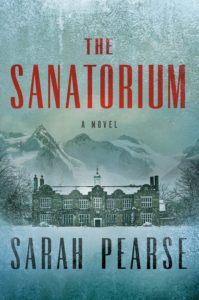Most crime writers love to torture their characters and put them in impossible situations—it’s what we do best, and that’s why isolated settings work so well. Whether it’s a group of strangers on an island, or friends who find themselves cut off from society due to extreme weather, staging a murder in a situation where those left behind are unable to escape or to contact the outside world for help adds an extra layer of threat and increases the tension. It allows for a closed cast of suspects—they’re the only ones there, so one of them must have done it—and provides the opportunity to bring in unreliable narrators so the reader is unsure of what really happened until the big finale. The added pressure of having to solve a murder in a short space of time can really heighten the tension, too. In Nowhere To Hide my characters are on a nature reserve in the middle of the English countryside, hampered by heavy snow, and they’re all trying to hide their own secrets while avoiding an unknown killer. Here are a few other examples of writers who have used isolated settings to their advantage:

The Bodies Left Behind, by Jeffery Deaver
Set in the forests of Wisconsin, this thriller deftly weaves together tension and a palpable threat level to keep the reader turning the pages. Two strangers, one of whom is an off-duty police officer, find themselves escaping from a cabin that has been the scene of a gruesome murder, and must trust each other in order to survive. Most of the plot takes place in just one night, adding a sense of urgency to the action.

One By One, by Ruth Ware
A group of colleagues from a tech company find themselves trapped in a luxury chalet due to an avalanche in this chilling thriller. With tensions rising within the group, and disagreements that could cost them a fortune, one of their number goes missing. When a second member of the group is found dead, it becomes clear that there’s a killer among them. Cut off from the town below, they must find a way to get help before the killer claims another victim.

The Guest List, by Lucy Foley
This excellent follow-up to The Hunting Party sees a magazine owner and her celebrity survivalist fiancé invite their nearest and dearest to a remote island off the coast of Ireland for their wedding. Secrets, lies, infidelity and dangerous games are all hinted at along the way, and the sense of isolation is heightened as a storm rolls in just as a body is discovered. The narrative timeline is mixed up, gradually leading the reader through the events and interactions that culminate in murder, leaving you guessing at the identity of the victim as well as the killer until the final act.

Bullet Train, by Kotaro Isaka, translated by Sam Malissa
A disparate group of criminals find themselves on the same train from Tokyo, all with slightly different goals, yet they all end up looking for the same suitcase. While this location isn’t quite as isolated as some of the others—the train still stops and they have opportunities to get off—there’s something about the sinister violence taking place on a speeding bullet train that adds an extra burst of adrenaline to the action. Dark and brutal, but with some well-placed comic relief, this one will leave you wondering who’s plotting against whom.

The Seven Deaths of Evelyn Hardcastle, by Stuart Turton
A man wakes up in the woods, not knowing who he is or why he is there, until he finds his way to a nearby manor house where a weekend party is taking place. This is a highly accomplished and unique novel that sees the main character reliving one day repeatedly, but each time inhabiting a different person’s body, seeing what happened from their point of view. It has an eerie, supernatural twist, that our main character cannot escape this constant repetition, or pass the boundaries of the mysterious property where he’s found himself, until he has discovered who murdered the eponymous Evelyn Hardcastle.

The Lighthouse, by Fran Dorricott
A group of friends get together for a weekend away in an old lighthouse that has been converted into a holiday home. It’s situated on its own island, and there are no other inhabitants, and no way for the group to leave before the boat returns for them. Tensions are running high within the group, several of whom are keeping secrets from the others, then strange things begin to happen—objects start to go missing, one member of the group gets lost, and they discover a strange, abandoned cabin. Are they alone on the island? Claustrophobic and eerie, the characters all feel a little unreliable and keep the reader guessing.

The Sanatorium, by Sarah Pearse
Elin is on a break from her career in the police force and has been invited to her brother’s engagement party in a hotel high on a Swiss mountain. The hotel used to be a tuberculosis sanatorium, and its conversion is shrouded in controversy: the original architect disappeared, and many locals opposed the project. Not long after she arrives, her brother’s fiancée goes missing, then an avalanche traps a handful of guests and staff in the hotel just as a body is discovered. This novel is intensely creepy and uses the isolation of the setting to great effect.

They All Fall Down, by Rachel Howzell Hall
Seven strangers are all brought to an island off the coast of Mexico, all enticed by different invitations. It’s soon revealed that nothing is as it seems, and each of them has something to hide. Our narrator, Miriam, is unreliable enough to keep the reader wondering, but not so much so that we don’t empathise with her. With no mobile signal or wifi, and a satellite phone that’s mysteriously gone missing, the group are cut off completely when everything goes horribly wrong.

Hostage, by Clare Mackintosh
Where could you feel more isolated than on a plane at 40,000 feet? This adrenaline-fueled thriller sees Mina, a flight attendant on board the first non-stop London to Sydney flight, faced with a terrible decision. Someone has threatened her daughter, who is back at home, and Mina must risk either her daughter’s life or the lives of everyone on the plane. The race against time really pushes the pace, and there are plenty of twists to keep the reader wrong-footed until the very end.

And Then There Were None, by Agatha Christie
Agatha Christie used isolated settings in several of her most famous novels, including islands, moving vehicles, and destinations that become isolated due to the weather. This list wouldn’t be complete without the inclusion of this absolute classic of the genre, which has been adapted numerous times and inspired countless other authors, including some of the other books in this list. A group of apparent strangers are invited to an island, not realizing that they are all connected. It soon becomes clear that someone wants them all dead and they are picked off, one by one. As their number dwindles, none of the characters know who they can trust, heightening the tension until the dramatic conclusion.
***


















